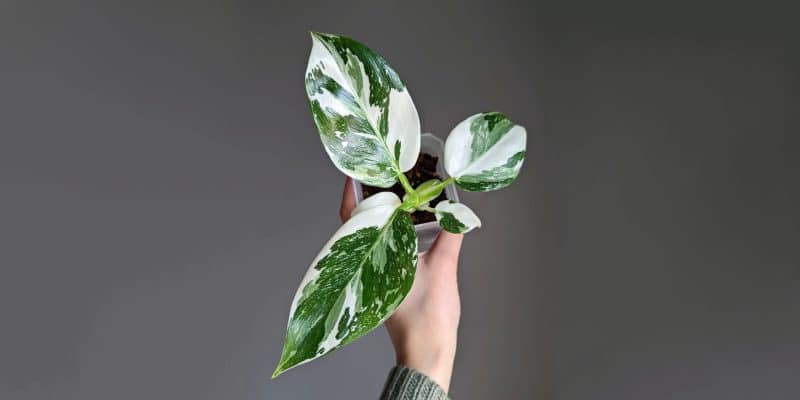We’ve all been there, wandering the aisles of a garden center, when, as if by magic, we spot a plant that casts a spell on us: the Philodendron White Wizard. With its enchanting white and green leaves, this houseplant is sure to bewitch both your heart and your home.
Chances are, you’re eager to learn more about this philodendron variety and how to make it thrive in your home. That’s where we come in! We’ll guide you through the sorcerous world of Philodendron White Wizard care, from its origins and ideal environment to propagation and common issues.
Table of Contents
Philodendron White Wizard Plant Care Guide
History, Habitat, and Characteristics
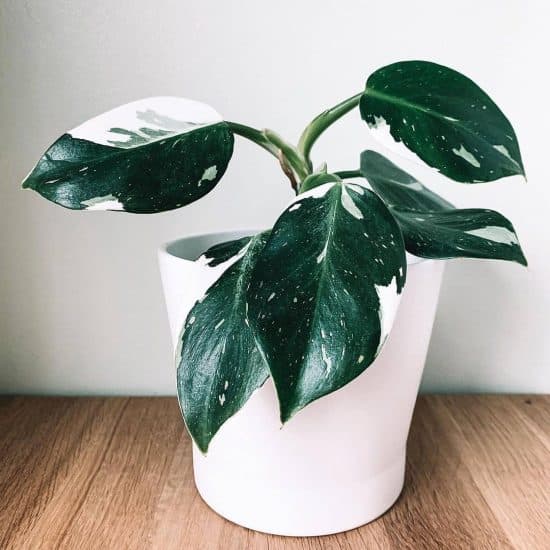
Philodendron White Wizard (Philodendron erubescens ‘White Wizard’) finds itself among a group of mysterious and alluring houseplants. Alongside its siblings, Philodendron erubescens ‘White Princess’ and Philodendron erubescens ‘White Knight,’ their origins remain largely unknown, though these hybrids likely have Central or South American roots.
Plucked from obscurity and thrust into the limelight, the Philodendron White Wizard has recently risen in both availability and popularity. Once considered a rare hybrid, the plant’s mesmerizing green and white heart-shaped leaves have hooked plant lovers everywhere.
The White Wizard, like a true adventurer, prefers to climb its way to the top. By providing a moss pole or another support structure, you’ll ensure this valiant climber prospers. It may not be a speedster, but the White Wizard’s growth rate holds its own among fellow philodendrons.
Varieties
There are at least 6 cultivars of Philodendron erubescens. The Philodendron White Wizard, White Princess, and White Knight may seem like triplets at first glance, but a close examination of their stems, petioles, and leaves reveals their individual quirks and charm.
Although the White Wizard, White Princess, and White Knight philodendrons share some family traits, such as their heart-shaped leaves and abundant aerial roots, each has its distinct flair. The Philodendron White Wizard sports green and white stems and petioles, complementing its green and white foliage.
In contrast, Philodendron White Knight boasts violet and white stems, violet and white petioles, and green and white leaves with a hint of violet streaks.
Philodendron White Princess stands out with her green, white, and pink stems, pink, white, and green petioles, and green and white leaves elegantly embellished with pink variegation.
Light
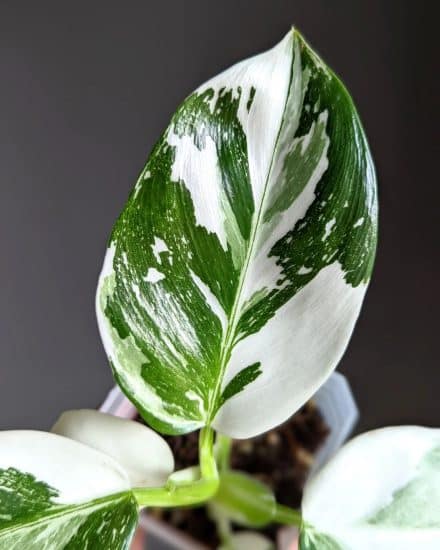
To provide the ideal indoor lighting for a White Wizard philodendron, it’s crucial to consider both its natural habitat as a tropical plant and its stable variegation.
This stunning plant thrives in bright ambient light, especially due to its high variegation. With the white parts of the variegated leaves limited in photosynthesis, bright indirect sunlight plays a key role in helping the green areas maximize their energy production.
You can place your White Wizard philodendron in medium light, but if you really want to make that variegation pop, opt for bright indirect sunlight. Early morning and late afternoon direct sun is perfect, just remember to keep your plant away from harsh midday sun exposure.
Now, if your plant is getting too much direct sun, it might show leaf burn, fading leaf color, and a scorched appearance that you definitely don’t want. In this case, think about adding a sheer curtain to soften the sunlight, or move your plant to a spot with less direct light.
On the other hand, if the light is insufficient, you’ll notice slow, leggy growth and variegation becoming less distinct.
Water
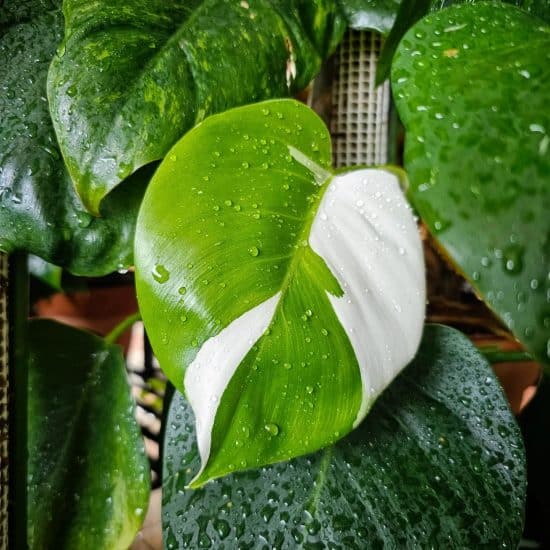
Watering your White Wizard Philodendron is all about finding the right balance to keep the plant thriving and healthy. The best strategy is to assess the soil moisture by poking it with your finger or using a moisture probe. If the reading indicates dry conditions, it’s time to water.
During the growing season (spring and summer), water when the soil is about 25% dry. This is the time when the plant is actively growing and needs more moisture. In winter, when the plant goes dormant and needs less water, let the soil dry to about 50% before watering.
Fully soak the soil during each watering session, ensuring excess water drains out through the drainage holes to prevent water logging and poor drainage.
Signs of your White Wizard Philodendron not receiving enough water include droopy, wilted, or yellow leaves. The edges may also be crispy or brown. If you notice these symptoms, increase your watering frequency, but avoid letting the soil become completely wet.
Too much water can cause yellowing of leaves throughout the plant, as well as soggy or mushy stems. In this case, reduce the watering frequency and allow the soil to dry out more before the next watering session. Be on the lookout for root rot, which requires further intervention to save the plant.
Temperature and Humidity
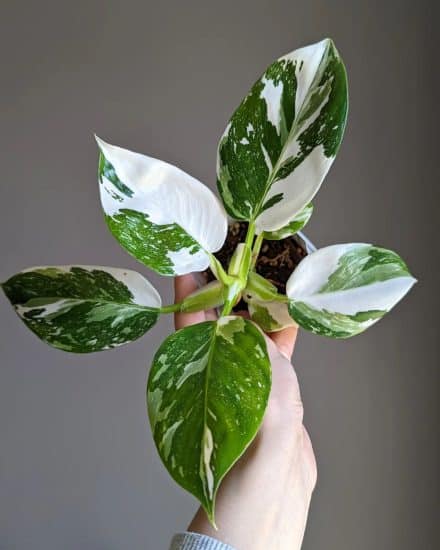
When it comes to temperature, as a tropical houseplant, White Wizard philodendron enjoys warmth due to its rainforest origins. You’ll want to maintain a steady indoor temperature range of 65-80°F (18-27°C). Since this tropical plant is sensitive to cold, keep it away from cold drafts or sudden temperature drops, especially during winter months.
Your White Wizard philodendron prefers a humid location, around 60%-80%. If humidity is too low, you might notice drooping leaves or brown tips, signaling the need for more moisture.
Keep in mind, though, that excess humidity can lead to mold or mildew on the leaves. Ensuring proper ventilation is crucial to prevent these issues, so place your plant near a window or in a well-ventilated area.
Soil and Planting
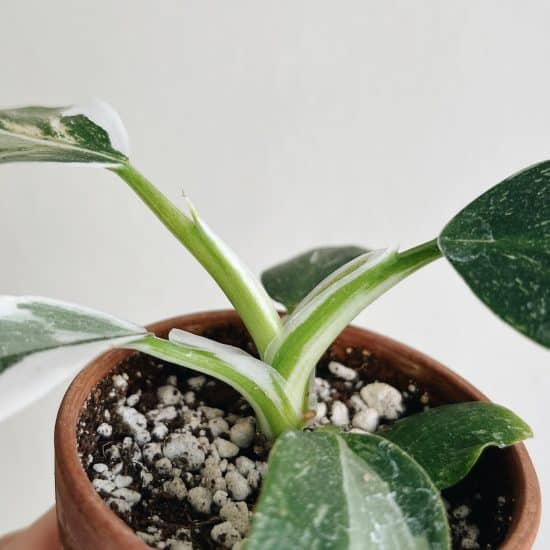
White Wizard philodendron requires a well-draining, airy, slightly porous soil that can retain some moisture and provide good circulation for the roots.
Our ideal Philodendron White Wizard soil mix:
- Use one part regular potting soil as the base for your mix to provide essential nutrients and help retain moisture, important for keeping the roots healthy and hydrated.
- Add one part perlite or crushed granite for enhanced drainage and aeration.
- Include some orchid bark or coconut coir in the mix for moisture retention and improved aeration.
For those who prefer using soilless mediums, the White Wizard can also thrive in a mix made of 100% rice hull or labhang. Just make sure it’s decomposing and not fresh. Avoid using garden soil, which tends to be too dense, and lacks the necessary aeration and drainage needed for healthy growth.
Repotting
Repotting your White Wizard is an essential part of its care routine. Repotting ensures there’s enough space for the roots to grow, prevents root binding, and maintains the overall health of your philodendron.
As the plant grows, move up one pot size, only increasing a couple of inches in diameter and height. You’ll usually need to do this every one to two years, or when roots start emerging from the bottom drainage system. Choose a pot made of similar material to the last one, and make sure it has adequate drainage holes.
Fertilizer
Philodendron White Wizard will benefit from fertilizer during its growing season. Opt for one with more phosphorus and less nitrogen, like a 15-30-15 NPK ratio fertilizer. Mix 1 teaspoon of fertilizer with 2 gallons of water to create the ideal solution.
To avoid shocking the plant, water it with plain water before adding the fertilizer solution. If you notice signs of over-fertilization, such as yellowing leaves, burned leaf edges, or weak growth, remove any visible salts from the soil surface and flush the soil with water to help dilute the excess nutrients.
Propagation
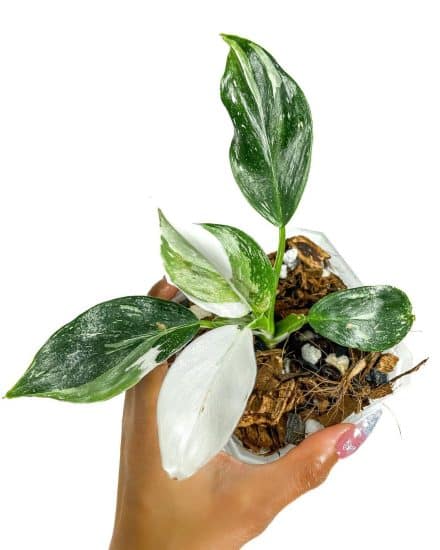
Propagating your White Wizard Philodendron is a fun and easy way to multiply your plant collection.
Propagating Philodendron White Wizard via stem cuttings:
- Gather your tools and materials. You’ll need sterilized gardening shears or a sharp knife, a small pot filled with porous potting soil or Lechuza PON, and a healthy White Wizard philodendron plant to take the cutting from.
- Choose the perfect stem for cutting. Look for a robust stem with green variegated leaves and at least one or two aerial roots. Try to pick a cutting that’s about 4-6 inches long. The aerial roots will help your cutting take root in its new home more quickly.
- Snip the stem. With your sterilized shears or knife, carefully cut the chosen stem just below a leaf node. A clean cut helps keep the plant as healthy as possible and prevents fungal leaf spot.
- Remove lower leaves. Gently pluck any leaves from the bottom inch or two of the cutting. This will create space for the aerial roots to settle into the new medium and prevent the leaves from rotting.
- Plant your cutting. Stick the freshly-cut end of the stem into the prepared pot of moist rooting medium. Make sure the aerial roots are touching the medium to encourage new root growth. (You can also root in a clear glass of water first to keep an eye on the root growth).
- Create the perfect environment. Place the pot in a warm spot with bright ambient light, avoiding direct sun. Keep the medium consistently moist but not soggy, as this can cause rot. Maintain high humidity for successful propagation — consider covering the pot with a clear plastic bag to trap moisture.
- Watch for growth. Over the next few weeks, keep an eye on your cutting for new growth and roots. Once the cutting has a healthy root system and some new leaves, you can transfer it to a larger pot with regular potting mix.
Common Issues
Philodendron White Wizards, while gorgeous tropical houseplants, can occasionally face some common problems. Luckily for you, they’ve also got common solutions!
Fully White Leaves
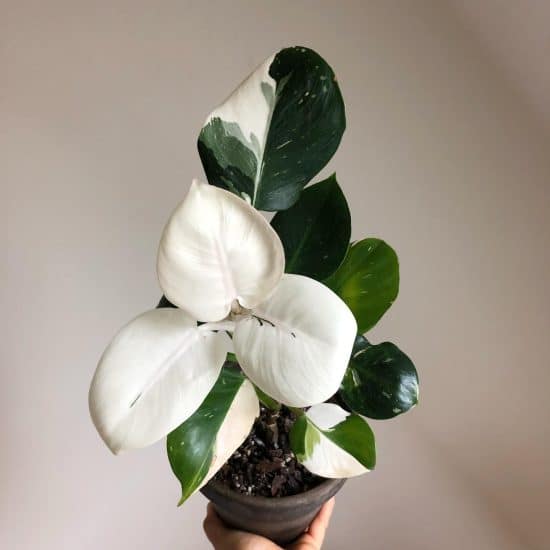
Stunning as they may seem, fully white leaves on a White Wizard Philodendron can be problematic. These leaves draw energy from the plant without contributing any in return through photosynthesis (not a very even deal, is it?).
Should you spot a completely white leaf, we suggest taking a picture to admire its beauty, and then snipping it off — it’s essentially a “freeloader” on your plant.
To prevent more white leaves from sprouting, make sure your climbing philodendron receives plenty of indirect light, and maintain a balanced watering schedule. Gently cleaning the green leaves by spraying a bit of water and wiping with a soft cloth can encourage photosynthesis — just remember to be extra cautious with newly unfurled leaves, which can be quite delicate.
Yellowing Leaves
While it’s natural for older leaves at the base of the White Wizard philodendron to turn yellow, too many yellow leaves could be a sign of a problem. The common culprits include inconsistent watering, excess sunlight, or insufficient nutrients in the soil.
To get this issue under control, begin by trimming away any yellow leaves. Ensure that your plant is shielded from direct sunlight, and instead provide bright but indirect light. Stick to a consistent watering schedule, allowing the soil to dry out between waterings, and opt for a balanced fertilizer to encourage healthy growth.
Pests and Diseases
White Wizard philodendron generally flourishes indoors, but you’ll need to watch out for a few common problems, such as root rot, fungus, and pests.
Root Rot
Like many tropical plants that prefer a seeming paradox of damp soil but good aeration, White Wizard philodendron can be prone to root rot. Root rot occurs when a plant’s roots are left in excess water or poorly draining soil, leading to decay. It usually requires adjustments to the pot and growing medium, or even a switch to LECA (lightweight expanded clay aggregate).
To identify root rot, look for yellowing leaves, wilting, and a foul odor coming from the soil. Remove your plant from its pot and trim away any mushy or discolored roots. Place the plant in a pot that has drainage holes and a well-draining potting medium. Be mindful of your watering habits to avoid overwatering in the future.
Fungus
Fungal issues can also affect your White Wizard philodendron, causing unattractive damage to your plant. Symptoms of a fungal problem include white or yellow spots on the leaves, powdery-looking growth on the foliage, and blackened or rotting stems.
To treat fungal issues, begin by isolating the affected plant to prevent the infection from spreading. Remove any infected leaves or stems, then apply a fungicide according to the product’s instructions. Improve air circulation around your plant and avoid overwatering — damp conditions can promote fungal growth.
Pests
Spider mites, mealybugs, and aphids can occasionally be an issue for your White Wizard philodendron. These pests feed on your plant’s sap, causing leaves to yellow, curl, or drop. They may also leave behind a sticky residue or webbing.
To combat these infestations, start by isolating your plant to prevent pests from spreading. Gently wipe the leaves and stems with a damp cloth, removing as many pests as possible. In cases of more severe infestations, you may need to use a targeted insecticide.
Conclusion
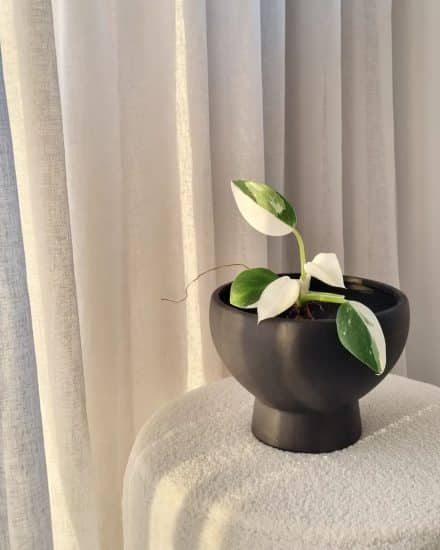
That’s a wrap for our Philodendron White Wizard care guide!
With its captivating variegation and mysterious origins, the Philodendron White Wizard is a truly magical addition to any plant collection. As you nurture this magical specimen, remember the key elements of its care:
Philodendron White Wizard care summary:
- Provide bright, indirect light and shield from harsh midday sun to showcase its stunning variegation.
- Water consistently, allowing the soil to dry out partially.
- Maintain a warm temperature range of 65-80°F (18-27°C) and high humidity (60%-80%).
- Use well-draining, airy soil that retains some moisture.
- Fertilize with a balanced fertilizer during the growing season.
We hope this guide has equipped you with the knowledge and inspiration to embrace the alluring world of the Philodendron White Wizard. If you found this article helpful, don’t forget to share it with fellow plant lovers!
Now, go forth and cultivate some plant magic with your enchanting White Wizard. Take care!
FAQ
How rare is Philodendron White Wizard?
The Philodendron White Wizard is considered a somewhat rare houseplant due to its unique and striking appearance. While not impossible to find, you may need to search a little harder to locate an in-person or online nursery that stocks them.
To increase your chances of finding one, visit specialized plant shops, attend plant swaps, or network with fellow plant lovers. The hunt is worth it — this stunning plant will make a captivating addition to your indoor jungle.
What is the difference between Philodendron ‘White Knight’ and Philodendron ‘White Wizard’?
The main difference between the philodendrons White Knight and White Wizard lies in their foliage. Both cultivars have a magical blend of green and white, but the White Knight features white variegation on its stems, while the White Wizard has green stems.
Additionally, the White Knight’s leaves are typically more narrow and elongated than those of the White Wizard. Apart from this, their care requirements are very similar, so you can follow the same guidelines for watering, temperature, and humidity for both plants.
Does a White Wizard Philodendron climb?
Yes, Philodendron White Wizard is a climbing and vining plant. In its natural habitat, it would use aerial roots to climb trees, rocks, or other vertical structures. To mimic this growth behavior, provide a support system like a moss pole or a sturdy trellis. This will encourage your White Wizard to climb, and can also help manage its growth and appearance.
Do Philodendron White Wizards revert?
Philodendron White Wizard, like other variegated plants, can sometimes revert to their original, all-green form. Reverting typically occurs when the plant isn’t receiving adequate light.
To prevent this, ensure your White Wizard is placed in a spot with bright, indirect light, which will support the variegation in the leaves. If you notice new growth reverting, you can prune it back to encourage the plant to produce more variegated leaves.
Why is my White Wizard turning brown?
If your Philodendron White Wizard is turning brown, this is a sign that something is off with its growing environment. Browning leaves can be caused by low humidity, underwatering, or overexposure to the sun.
Evaluate your care routine and make necessary adjustments to address these issues. Ensure your plant is placed in a bright, indirectly lit area, and that you’re maintaining high humidity levels (60%-80%). Additionally, check the soil moisture and adjust watering accordingly, keeping the soil consistently moist but not waterlogged.

